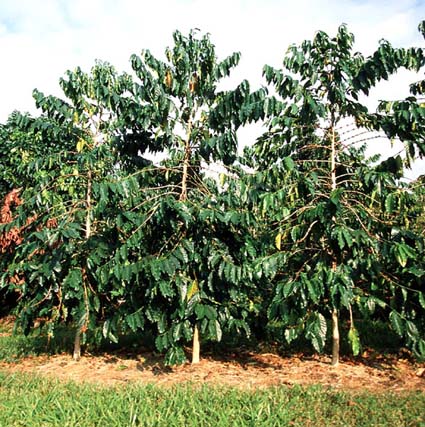Coffee beans and coffee trees types of coffee trees
In general, coffee trees can grow to 4-5 meters high, and even 9-10 meters high.

Single coffee tree
But in places where coffee is grown artificially, people cut off the branches at the top when the coffee tree grows to three meters high, so that the coffee tree does not grow too high, so that it can be picked during harvest.
According to botanical classification, coffee trees belong to
Domain: eukaryotic biomass domain, Eukaryote
Realm: plant kingdom, Plantae
Phylum: angiosperm phylum, Magnoliophyta
Class: dicotyledonous class (Magnolia), Magnoliopsida
Item: gentian, Gentianales
Family: Rubiaceae, Rubiaceae
Genus: coffee, Coffea
1. Types of coffee trees
In order to better understand coffee, coffee trees are divided into the following different species in the genus Coffee.
Arabica grows coffee trees, Coffea Arabica
Canifra grows coffee trees, Coffea Canephora
Grow coffee trees in Liberia, Coffea Liberica
Exelsa grows coffee trees, Coffea Excelsa
De Viri grows coffee trees, Coffea Dewevrei
Cassana grows coffee trees, Coffea Khasiana
Arnoldiana grows coffee trees, Coffea Arnoldiana
Abiokuta grows coffee trees, Coffea Abeokutae
Vitiana grows coffee trees, Coffea Wightiana
Ben Galansis grows coffee trees, Coffea Bengalensis
Travenko Renses grows coffee trees, Coffea Travencorensis
Rismosa planted coffee trees, Coffea Racemosa
Saladrix grows coffee trees, Coffea Salvatrix
Conkinsses grows coffee trees, Coffea Congensis
Capaca grows coffee trees, Coffea Kapakata
Sdinofera grows coffee trees, Coffea Stenophylla
Okini Oydes grows coffee trees, Coffea Eugenioides
Zankuibalia planted coffee tree, Coffea Zanguebariae
Among the above kinds of coffee trees, the first two are mainly used to make coffee drinks.
Arabica coffee, formerly known as "small seed coffee", originated from Ethiopia
Is the most widely cultivated and used to make coffee beverages, accounting for more than 70% of the world's total.
Canifra grows coffee, formerly known as "medium seed coffee", originally from the Congo.
Slightly less than 30% of the world's total output
The third category is
Liberica grows coffee, formerly known as "large seed coffee", originally from Liberia.
Although the selling price of this kind of coffee is very low, because of its poor taste, few people buy it and use it to make coffee drinks. Now it is rarely planted in places such as Malaysia, and it is usually rarely seen on the market and almost impossible to buy.
Other types of coffee trees have not yet been used to make coffee drinks from their beans, but most of them exist in the Ethiopian rainforest and are protected by the Ethiopian government. Maybe one day we will get better coffee beans from these coffee trees that have not yet been used to make coffee drinks!
(a) two kinds of practical coffee
Since other coffee trees are not used to make coffee drinks, we don't have to talk too much about them. What we are most concerned about is the two kinds of coffee that are mainly used to make coffee drinks.
Arabica grows coffee beans, and Arabica grows coffee trees.
Robbas special coffee beans, grown in Canifa.
These two kinds of coffee trees are suitable for planting in different areas, the coffee beans have different taste characteristics, need to use different processing methods, and can be used to make different coffee drinks. If you don't understand the characteristics of these different kinds of coffee, you don't know how to properly use and process these coffee beans to make a good coffee drink.
The reason why we first emphasize these two different kinds of coffee is that there are many very different aspects of these two kinds of coffee, so it is one of the basic concepts for us to understand coffee. Paying attention to the distinction between these two different types of coffee is the basis and key to understanding coffee.
(B) different growth environments
The suitable environmental conditions for the growth of coffee trees in Arabica are that the annual temperature varies from 15 to 25, the annual rainfall is between 1500 and 2000 mm, and it should be in line with the flowering period of coffee trees. In addition, the growth of coffee trees also has high requirements for the soil. If the soil is not fertile enough and the nutrients, including a variety of trace elements, are not enough, it may affect the growth of coffee trees and the formation of flavor components of coffee beans. Therefore, the soil environment composed of volcanic ash provides very favorable soil conditions for the growth of coffee trees.
Although the growth of Arabica coffee trees needs sunlight, the strong direct sunlight is disadvantageous to the growth of Arabica coffee trees. The growth of Arabica coffee trees is more suitable for reflecting sunlight through other canopies. Therefore, in areas where coffee is artificially planted, intercropping is generally used. That is, for each row of coffee trees, a row of taller, larger crowns, such as banana trees, should be planted in the middle to shade the coffee trees. However, in Yunnan, where there are few sunny days and mostly rainy days, not interplanting will not be detrimental to the growth of coffee trees, but will also greatly increase the yield of coffee per mu.
The environmental conditions suitable for planting coffee trees in Arabica limit the most suitable areas for planting coffee trees in Arabica are tropical or subtropical alpine areas, generally at an altitude of no less than 800m to 1000m. Because the year-round temperature in the plain is too high, it is not suitable for the growth of coffee trees in Arabica. But the highest is usually no more than 2000 meters, because frost may occur in areas too high above sea level, and coffee trees may freeze to death in the event of frost. So even Arabica coffee trees cannot be planted in areas too high above sea level.
Sometimes we see the so-called "shady coffee" (shading coffee) in the market. These coffees are generally grown and harvested in the "shade" of the mountains. Because there is no or little sunshine on the shady side, the coffee beans harvested on the coffee trees grown here will have better taste characteristics. It is because Arabica coffee trees do not like the sun, so coffee beans grown and harvested in such areas will have a better taste. However, this is only a small part, there is no particularly strong reaction.
In contrast, coffee trees grown in Canifra require higher ambient temperatures, ranging from 24 to 29 degrees throughout the year, and prefer direct sunlight. So growing coffee trees in Canifra is suitable for growing in tropical or subtropical low-altitude areas. Its most important feature is resistance to diseases and insect pests and is not likely to be affected by insect pests. Therefore, the areas where coffee trees are planted in Canifra are tropical or subtropical low-altitude areas.
(C) differences in taste characteristics
There is a big difference in taste between coffee beans grown in Arabica and coffee beans grown in Robastian (grown in Canifa). It even affects that different coffee beans are suitable for processing in different ways and are used to make different coffee drinks. Therefore, it is very important for us to distinguish between these two kinds of coffee beans.
Arabica grows coffee beans:
The taste is delicate and soft, often with different taste characteristics due to variety and origin, such as the taste of different fruits, different nuts, chocolate, and so on.
Robbas special coffee beans:
The taste is strong and rich, sometimes with a fishy, spicy, and other bad taste. Some people can even smell the smelly charred rubber when roasting roast coffee.
Because of the great difference in taste, Arabica coffee has always been considered to be of higher quality than Robaster coffee and is sold at a higher price in the international market. Robbas special coffee is sold at a lower price in the international market because of its poor taste. Of course, this is not absolute. If carefully selected, Robaster coffee can also choose a lot of very good coffee, and the price is not lower than that of ordinary Arabica coffee. This has left such a deep impression on people for a long time that up to now many people still cannot accept the use of Robaster coffee to make coffee drinks. Whether it's drip coffee or espresso.
The above taste is the feeling when making drip filter coffee, but the taste when making espresso is probably different. We will discuss more about growing coffee beans in Robaster later.
Important Notice :
前街咖啡 FrontStreet Coffee has moved to new addredd:
FrontStreet Coffee Address: 315,Donghua East Road,GuangZhou
Tel:020 38364473
- Prev

Know more about Turkish coffee.
Turkish coffee, also known as Arabica coffee, is the ancestor of European coffee, which has a history of 700 to 800 years. The reason why we have to mention Turkish coffee when it comes to coffee is that no matter from the perspective of Islam or Christianity, the origin of coffee is in the remote and mysterious mountains of the Middle East. Coffee was born in Turkey in the 16th century, was commercialized and quickly spread to Europe.
- Next

Italian latte A classic blend of espresso and milk.
Latte is the transliteration of Italian Latte. Latte (CoffeeLatte) is a kind of fancy coffee. Latte is a classic blend of Italian espresso and milk. Italians also like lattes as breakfast drinks. In the Italian kitchen in the morning, coffee and milk are usually brewed on the sunlit stove. The Italian who drinks lattes, not so much him.
Related
- Beginners will see the "Coffee pull flower" guide!
- What is the difference between ice blog purified milk and ordinary milk coffee?
- Why is the Philippines the largest producer of crops in Liberia?
- For coffee extraction, should the fine powder be retained?
- How does extracted espresso fill pressed powder? How much strength does it take to press the powder?
- How to make jasmine cold extract coffee? Is the jasmine + latte good?
- Will this little toy really make the coffee taste better? How does Lily Drip affect coffee extraction?
- Will the action of slapping the filter cup also affect coffee extraction?
- What's the difference between powder-to-water ratio and powder-to-liquid ratio?
- What is the Ethiopian local species? What does it have to do with Heirloom native species?

